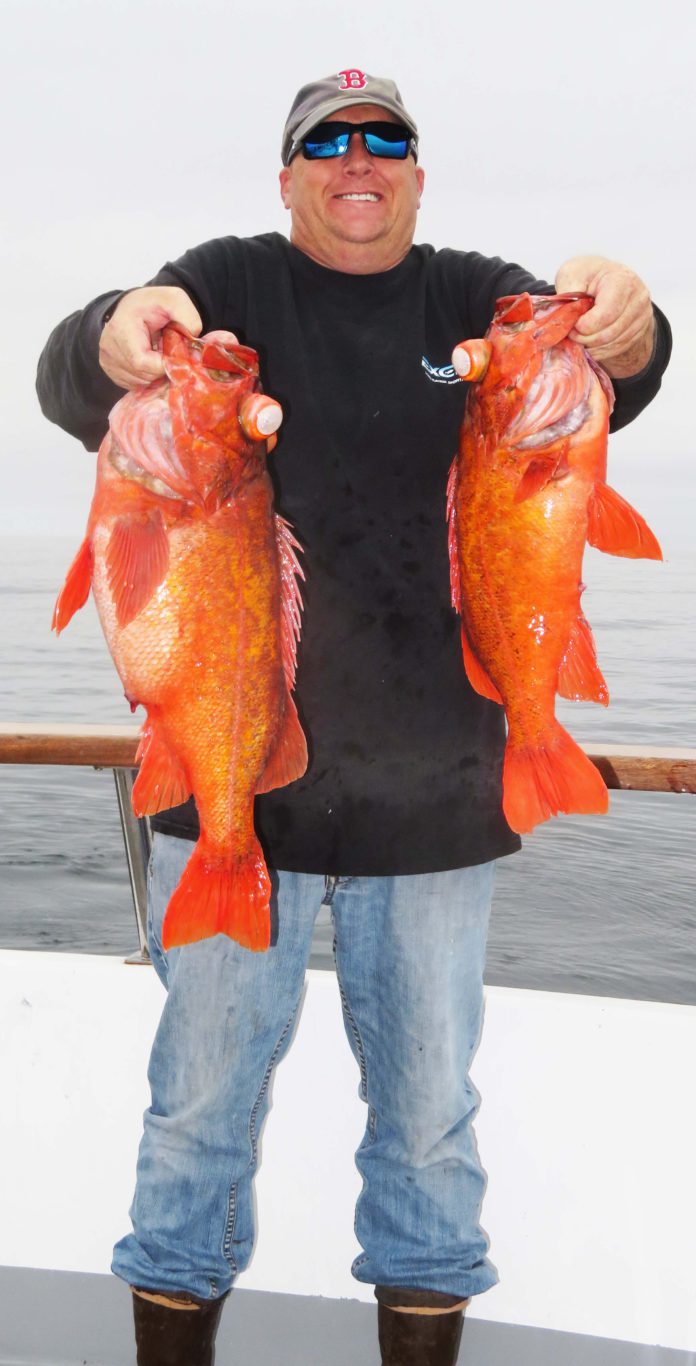BY MERIT McCREA
FRESNO — 210.7 tons red, 87.32 of copper and just 2 of quillback – those were the numbers – the ones that our CDFW staff and fisheries representatives had to keep 2024 harvest projections under at the Pacific Fisheries Management Council (Council) today, and we’d been working on it coast-wide for the past month.
It was all about what the regulations for this year’s rockfish season will be. Fancy math models were used to project the catch by month and considered the depth areas open and usual angler numbers and such.
Of course, the simple way would be just to open it all up and let’er rip until we were out of one or another species, then end the season.
But sadly that would mean the season might only last a month or so until we ran out of those 2 measly tons of quillback up north.
But wait, there’s no quillback south of Monterey really. Maybe those ports from Morro south could roll for a bit longer, then run out of coppers or reds after a couple of months of glory, 10 rockfish of any kind fishing anywhere.
None of that works very well. Tons of other rockfish of other kinds would be left out there off limits because we’d run out of quillback, or reds or coppers.
Instead fisheries representatives from Eureka to San Diego, working with the Council’s Groundfish Management Team – biologists from CDFW, Washington and Oregon went to work figuring out a way to target those other fish while avoiding quillback and slowing the catch of coppers and reds so the lasted longer.
It’s resulted in 9-month California rockfish seasons. Today the season structure as it’s called passed its highest hurdle, being approved by the Council or PFMC.
Here’s how it works. For north of 36 N. Lat. at Point Lopez between Morro Bay and Monterey quillback were the issue. Avoiding the depths between 120 and 300 feet – 20 to 50 fathoms, the seasons are either outside 50 or inside 20 but not both at once, due to enforceability issues.
Because quillback are still caught shallower and some die even when released there was a limit on the inside of 20 time.
The North seasons will be April deep, May to the end of September shallow, October deep, November shallow and December deep.
For Morro Bay and south (south of Lopez) the plan is All Depths April 1 to June 30, then 3 months only shallower than 50 fathoms (300 feet), then the last 3 months deeper than 50 fathoms.
Daily sub-bag limits will be 0 quillback, 1 copper and 2 reds.
The low bag limit on reds combined with only 6 months access to deep waters in the south where reds are most abundant keeps the catch under the Annual Catch Limit through the 9-month season.
Up north it’s being out of waters between 20 to 50 fathoms that slows the red and copper catch enough, combined with those bag limits, as well as avoiding quillback.
This may seem complicated, but it keeps anglers out on the water fishing for rockfish with bigger bag limits for a 9-month season instead of just a couple of months – or less.
Now, we know there are a bunch of folks that will say it the commercial fisherman that take all the fish. But that’s BS. It turns out recreational anglers take 3 times as much as commercial – 75% of the reds. Last year commercials caught 97.5 tons of reds – recreational anglers – 295.2 tons.
Other folks will say, “you can’t kill too many fish fishing hook and line.” That’s also not true. It might be impossible to cause a species to go extinct fishing that way, but you can certainly fish it down so low it’s not worth fishing for anymore.
Even more will say “those scientists don’t know what’s really out there.” That may be true, and they’ll admit it. But unfortunately there’s no one else that knows any better. As fishers just see the zone we fish.
When some local rock has no rockfish bigger than your hand we just assume it’s because that’s the way local rocks are. Out at the farthest islands we fish on overnight trips there are big rockfish, plenty of them. Deep down, we all know the truth about those local rocks.
If we want the scientists to know better they’ll need to have the data they currently don’t. Perhaps they’re stuck thinking the whole coast is more like those local rocks than the outer island reefs.
Credit for figuring out how to wring 9 months of rockfish access out of a few weeks’ supply of the most restricting species goes to people who worked with us like CDFW staffers Melanie Parker, James Phillips, Marci Yaremko and Caroline McKnight.
Our team consisted of many people, notably at the Council meeting this past week were Tim Klassen of Reel Steel Sportfishing in Eureka, Dave Kasheta with Coastside Fishing Club, myself and Jaime Diamond with the Sportfishing Association of California, Wayne Kotow for CCA-Cal and Capt. Louie Zimm representing private boaters.
From here the season plan goes to the National Marine Fisheries Service for approval there and then to the Fish and Game Commission for adoption in state waters.



